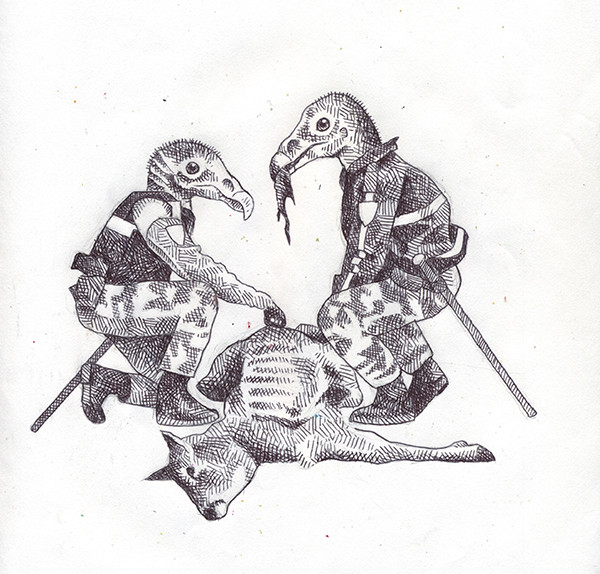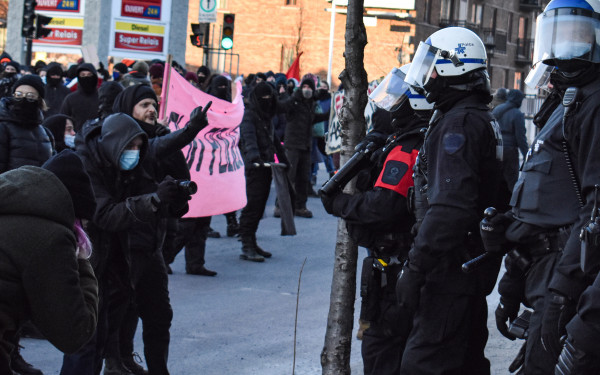Understanding Police Militarization in Montreal
Heavily armed riot police patrolling the streets of Black neighborhoods in military vehicles is becoming a common image in the United States.
From Ferguson in 2014 to Charlotte right now, a lot has been said about police militarization to our south.
This phenomenon isn’t limited to the States, though—it can also be seen here in Montreal. Anybody who’s been to night protests in the last couple of years can tell you about the military tactics displayed by the Service de police de la Ville de Montréal’s tactical units. Clad in black, they’re frequently seen marching in formation while the protesters chant Darth Vader’s theme from Star Wars.
When the riot police jump on the buses they use to get to and from protests, they act like soldiers in Kandahar—covering every angle with their grenade launchers, on the lookout for eventual snipers or suicide bombers. Except they’re not in Afghanistan, they’re in downtown Montreal, facing frightened students and protesters.
Since the 2001 Summit of the Americas in Quebec City—when Alter-globalization activists came from all over the world to protest the Free Trade Agreement of the Americas—Quebec’s police services started gearing up with modern riot control gear. The Sept. 11 attacks then accelerated the militarization of police forces all over North America—including Montreal. Here are some of the symptoms of police militarization in our city.
In 2014, the SPVM bought two Long Range Acoustic Devices—commonly known as sound cannons. These are weapons capable of projecting a concentrated beam of sound in excess of 145 decibels—as loud as a jet taking off—up to a kilometre away.
Sound cannons cause extreme discomfort, an instant headache and even hearing damage to anyone in it’s path. After the 2000 Al Qaeda suicide strike that damaged the USS Cole, the LRAD Corporation developed it as a less lethal alternative to heavy machine guns to defend US Navy ships from fast attack boats. It didn’t take long for the US military to start mounting LRADs on Humvees and other vehicles in Iraq and Afghanistan as a riot control device.
Since picking up the LRAD, the SPVM has been using it regularly. To be fair, it’s mostly used as a high-tech bullhorn. They said they would never use the alert mode—which is basically its weapon mode. Instead of a voice message, the cannon emits a loud screeching siren that is impossible to withstand.
But I’ve heard what appeared to be alert mode sound coming from the LRAD at a protest in spring 2015. Though I wasn’t in its beam I instantly recognized the siren from past footage of the sound cannon being used in the US against Black Lives Matter protesters. This means that the SPVM has broken their promise to only use the device as a means of communications.
Technology and tactics derived from the “War on Terror,” developed for fighting the Taliban and Al-Qaeda, shouldn’t be used on protesters and small-time criminals.
The SPVM has also rolled out a new digital radio system based on the Project 25 standard—P25 was developed for first responders and public security with radio encryption, and is born from the military.
It’s way over-budget, and less trustworthy than the old analog radios—it struggles to even pick up signal in elevators or in underground parking. Hackers have demonstrated that it is vulnerable to jamming. But luckily for them, it’s encrypted, so radio scanners won’t penetrate their communications.
This means that journalists won’t be on the scene before the police and that every scoop will have to come from the media relation’s team. Soon enough other first responders are supposed to join in the new standard—shutting down the constant crackling of radio scanners that run non-stop in newsrooms all over the city.
In 2013, the police spent $360,000 on an armoured truck called a Cambli International Thunder 1, developed in Saint-Jean-sur-Richelieu, Quebec. It is capable of withstanding fire from an assault rifle and is equipped with twelve gun ports. With its charcoal gray paint job, it looks like it’s from a Nolan Batman movie.
They said it would only be deployed for situations when they would face potential gunfire. And luckily we’ve yet to see a Ferguson situation where the police face peaceful protesters with an armoured personnel carrier. How long will it last, though?
Beyond the increasingly militarized equipment, police training may be changing as well. Following the riots in Montreal Nord in 2008—a response to the police killing of Fredy Villanueva—the SPVM held exploratory meetings with the Canadian Army on setting up training for dealing with hostile populations and situations which could become riots, including protests.
It is unknown how much training the Canadian Army has actually given the SPVM following those meetings.
Look, I support the Fraternité de la police in their fight against pension cuts. I enjoy seeing officers wearing funky pants, and the fact that Montreal city executives are bothered shows that it’s a good tactic. I had a good laugh when I saw a horse mounted police wearing fringed cowboy pants or the time when an officer wore Santa pants in the winter.
Most of the time, though, they’re wearing military camo cargo pants. What does this choice of outfit signify? As John Oliver said in an episode of his show Last Week Tonight, “police should dress for the job they have, not the one they want.”
I’m not asking for a return to the times of Samedi de la matraque—a riot during a visit by Queen Elizabeth II in 1964 in Quebec City in the beginning of Quebecois sovereignism. Then, more than 4,000 poorly trained policemen, equipped only with nightsticks and helmets, attacked everyone they saw with baton charges, wounding hundreds of protesters and bystanders in the process.
To be sure, police officers have a dangerous job and they deserve the right equipment to do it. But it should be sufficient for the threat they’re facing. Technology and tactics derived from the “War on Terror,” developed for fighting the Taliban and Al-Qaeda, shouldn’t be used on protesters and small-time criminals.
All of this undermines public trust in the police force, making it seem like the community they’re supposed to protect is seen as the enemy.
It’s easy to look at what’s happening in the U.S. and be shocked. But it’s also important to realize that American police didn’t become this way overnight—the process of militarization occurred over many years, and involved shifts in equipment and police culture. Military tactics and equipment gradually became normalized, and the police began to behave like an occupying army.
That shift—in equipment, tactics, and culture—is occurring right here, in Montreal. How long will we wait before we put an end to it?


_600_832_s.png)


_600_375_90_s_c1.jpg)
_600_375_90_s_c1.jpg)
